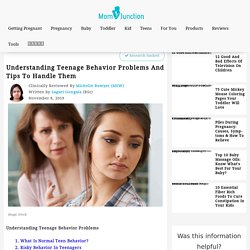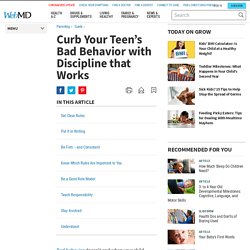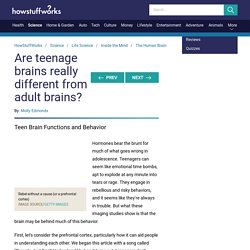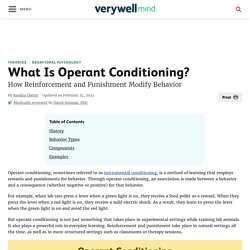

The following pointers construe the behaviours of teenagers as well as the artery of operant conditioning, namely the positive reinforcement, negative reinforcement, positive punishment, and negative punishment.
Strategies of disciplining teenagers work when parents communicate and role model the right expectations and consequences of behaviours with their teenagers.
Understanding How Teenagers function. Article 1: "Taking risky opportunities in youthful content creation teenagers’ use of social networking sites for intimacy, privacy and self-expression"
Article 1: "Taking risky opportunities in youthful content creation teenagers’ use of social networking sites for intimacy, privacy and self-expression"
Artcle 2: "Is This Typical Teenage Behavior or a Warning Sign of Mental Illness?" Some rebellious, irritable, or anxious behavior is a normal and healthy part of being a teenager.

However, when shifts in a teenager’s personality are more extreme, they may be indicators of a mental health issue. Concerning behaviors can sometimes be prevented when parents talk to teens frequently and have an open dialogue with them that’s supportive.Experts say even if parents aren’t sure whether or not a change in their teen’s behavior is something they should be worried about, it doesn’t hurt to check with a therapist, their child’s pediatrician, or a school counselor. Any parent of a teenager knows, teens can be moody, distant, and defiant at times. But while this can sometimes be a source of stress and conflict for families, it’s also usually a completely normal part of being a teen. “It’s important for parents to know this is normative behavior. In fact, Grubb said roughly 85 percent of teenagers “get through adolescence without too much angst.”
Artcle 2: "Is This Typical Teenage Behavior or a Warning Sign of Mental Illness?" Article 3: "10 Normal Teenage Behavior Problems And How To Handle Them" Understanding Teenage Behavior Problems Dealing with a teenager is not easy.

No matter how good a parent you are, and how great your relationship with your children is, you are likely to face parenting roadblocks when it comes to your teenager. Behavior problems are common in teenagers. But you can deal with them with ease if you are willing to put in the effort to understand what they are going through and what it is that they need from you. MomJunction gives you insight into teenage behavioral problems and how you can deal with them without straining the relationship with your child. Article 3: "10 Normal Teenage Behavior Problems And How To Handle Them" Article 4: "Teen Bad Behavior & Discipline Plans - Promoting Healthy Growth Ages 15 - 18". Bad behavior doesn't end when your child graduates from diapers -- or even from middle school.

In fact, the teen years can bring some of the toughest discipline challenges parents have to face. Sulking, arguing, lying, and rebelling are just a few of the ways teens misbehave. There's a good explanation for these bad behaviors. As teens become more independent, they still lack the emotional maturity they need to make informed, thoughtful decisions. Article 4: "Teen Bad Behavior & Discipline Plans - Promoting Healthy Growth Ages 15 - 18" Article 5: "13 Positive And Negative Influences Of Media On Teenagers" Image: Shutterstock “Whoever controls the media, controls the mind,” said famous singer and songwriter Jim Morrison.

Media plays an important role in shaping the ideas and beliefs of teens. In fact, continuous exposure to media has proven to impact a child’s social, physical, and mental development. In this post, we share with you the impact of media on teens with some relevant tips on how to handle media influence on children and adolescents. Article 5: "13 Positive And Negative Influences Of Media On Teenagers" Article 6: "Why Teenagers Act Crazy" Another patient I saw in consultation recently, a 23-year-old woman, described how she became anxious when she was younger after seeing a commercial about asthma.

“It made me incredibly worried for no reason, and I had a panic attack soon after seeing it,” she said. As an older teenager, she became worried about getting too close to homeless people and would hold her breath when near them, knowing that “this was crazy and made no sense.” B. J. Casey, a professor of psychology and the director of the Sackler Institute at Weill Cornell Medical College, has studied fear learning in a group of children, adolescents and adults. But when Dr. IN effect, adolescents had trouble learning that a cue that was previously linked to something aversive was now neutral and “safe.” This isn’t to say that cognitive therapy is ineffective for teenagers, but that because of their relative difficulty in learning to be unafraid, it may not be the most effective treatment when used on its own.
Article 6: "Why Teenagers Act Crazy" Article 7: "Teen Brain Functions and Behavior" Hormones bear the brunt for much of what goes wrong in adolescence.

Teenagers can seem like emotional time bombs, apt to explode at any minute into tears or rage. They engage in rebellious and risky behaviors, and it seems like they're always in trouble. But what these imaging studies show is that the brain may be behind much of this behavior. First, let's consider the prefrontal cortex, particularly how it can aid people in understanding each other.
We began this article with a song called "Parents Just Don't Understand," but as it turns out, teenagers don't understand well, either. But it's the combination of that prefrontal cortex and a heightened need for reward that drives some of the most frustrating teenage behavior. This behavior is evident on a much smaller scale as well; when a teenager goes to the mall to watch a movie but comes back with an iPod, then the prefrontal cortex didn't curb the impulse buy.
Related Articles. Article 7: "Teen Brain Functions and Behavior" Article 8: "New perspectives on adolescent motivated behavior: Attention and conditioning" Article 8: "New perspectives on adolescent motivated behavior: Attention and conditioning" What Is Operant Conditioning? Overview Image: Reinforcement & Punishment. Article 1: "What Is Operant Conditioning and How Does It Work?". Operant conditioning, sometimes referred to as instrumental conditioning, is a method of learning that employs rewards and punishments for behavior.

Through operant conditioning, an association is made between a behavior and a consequence (whether negative or positive) for that behavior.1 For example, when lab rats press a lever when a green light is on, they receive a food pellet as a reward. When they press the lever when a red light is on, they receive a mild electric shock. As a result, they learn to press the lever when the green light is on and avoid the red light. But operant conditioning is not just something that takes place in experimental settings while training lab animals. The History of Operant Conditioning Operant conditioning was first described by behaviorist B.F.
Through the first part of the 20th century, behaviorism became a major force within psychology. Early behaviorists focused their interests on associative learning. Types of Behaviors. Video 1: "The Use of Reinforcement and Punishment in Shaping a Child's Behavior". Video 2: "What is Operant Conditioning?". Video 3: "Skinner’s Operant Conditioning: Rewards & Punishments". Definition of Reinforcement. Simpson's Illustration of Positive and Negative Reinforcement. Overview Image of Reinforcement Theory of Motivation. Article 1: "What Is Reinforcement in Operant Conditioning?". One of the many different ways in which people can learn is through a process known as operant conditioning (also known as instrumental conditioning).1 This involves learning through reinforcement or punishment.

The type of reinforcement used can play an important role in how quickly a behavior is learned and the overall strength of the resulting response. Understanding Reinforcement Reinforcement is a term used in operant conditioning to refer to anything that increases the likelihood that a response will occur. Psychologist B.F. Skinner is considered the father of this theory. For example, reinforcement might involve presenting praise (the reinforcer) immediately after a child puts away her toys (the response).
Reinforcement can include anything that strengthens or increases a behavior, including specific tangible rewards, events, and situations. Article 2: "What Is Reinforcement? Psychology, Definition, And Applications" By: Toni Hoy Updated February 11, 2021 Medically Reviewed By: Whitney White, MS.

CMHC, NCC., LPC. Video 1: "Reinforcement Theory of Motivation" What Is Positive Reinforcement? Examples of Positive Reinforcement. Image of Positive Reinforcement shared between a teacher giving "High Five" to a student who obtained good grades. Article 1: "Positive Reinforcement for Adolescents" By the time children have reached adolescence, their responses are often ingrained, but parental actions can still positively affect adolescent behavior. Since adolescents are struggling to develop their personal identity and are concerned about their body image, parental support is crucial to help positively frame experiences as learning opportunities.
Positive reinforcement remains a powerful teaching tool during these formative years, and we encourage parents to take time to contemplate the ways they can help adolescents mature and become self-reliant. Reinforce mature decisions by allowing increased privileges when adolescent demonstrates increased responsibility. For instance, an adolescent who consistently demonstrates the ability to come home at the requested time might be allowed a later curfew - whereas an adolescent who has not completed requested chores will not be allowed to leave home that evening.Express pleasure at positive adolescent behavior.
Article 2: ''Parenting A Teen Through Positive Reinforcement - Back On Track". Most parents can agree: the teenage years can be rough!

Hormones are raging, they are trying to gain more independence, and they spend a lot of time away from their parents and their home while hanging with friends. One minute they love and adore you, the next minute you ruined their life. Can many of you relate? When tempers flare and disagreements are happening, it’s hard to not resort to yelling and harsh discipline, but studies are showing us that positive reinforcement may be the key to success, not just in the home but also in their school life. We’ve all heard the saying, “The one who is hardest to love needs love the most.”
As a student at My Virtual Academy, your teen will have weekly interaction with their teachers and mentors. In regards to school, if you notice your student is struggling, take a different approach and instead of getting mad or grounding your teen, commend them on something that you noticed they did well. Video 1: "The power of positive reinforcement" What Is Negative Reinforcement? Examples of Negative Reinforcement. Image of Negative Reinforcement (removing a "Happy Face" block) Article 1: "Negative reinforcement: Definition and examples"
Negative reinforcement encourages specific behaviors by removing or avoiding negative consequences or stimuli. It is different than punishment, which aims to discourage a specific behavior. Article 2: "Grounding a Teenager - Does it Really Work" Skip to content Menu Grounding a Teenager – Does it Really Work Home » Family » Teenagers » Grounding a Teenager – Does it Really Work By Staff When teenage mouths are running rampant with disrespect and the chores from last week are still piled high, covering the report card bearing three D’s and one F, grounding a teenager seems like a reasonable option.
When we think about grounding as a punishment, we have to consider our motivations. As adults, we realize that if we want to have our fun, we have to be responsible. Even if you made grounding attempts before, wipe your own personal slate clean and decide what it means to you when you ground your child. Video 1: "Negative Reinforcement". Definition of Punishment. Simpson's Illustration of Positive and Negative Punishment. Article 1: "The Study of Punishment in Psychology".
Punishment is a term used in operant conditioning to refer to any change that occurs after a behavior that reduces the likelihood that that behavior will occur again in the future. While positive and negative reinforcements are used to increase behaviors, punishment is focused on reducing or eliminating unwanted behaviors. What Is Positive Punishment? Examples of Positive Punishment. Image of a child having "Time Out" of facing the wall. Article 1: "What Is 'positive Punishment'? Definition And Real-World Examples". Positive punishment is a popular concept in parenting. We'll explain what it is and how you can implement it with six examples. Parenting isn't always a walk in the park, and determining the best way to address your child's inevitable poor behavior can be a tricky line to walk.
Techniques like positive punishment and negative reinforcement (two parenting "buzzwords" that you've probably heard a lot already) are just two of the ways parents and child care providers can try to correct a child's behavioral issues. [RELATED: "Parenting Styles: 4 Negative Reinforcement Examples "] If you decide to try out either -- or both -- of these parenting techniques, it's important that you first understand what they mean, what they do, and how you can incorporate this technique into your parenting style -- and how your babysitter or nanny can incorporate it into their care repertoire. Article 2: "Positive Punishment: What It Is, Benefits, and Examples". Article 3: "Using Positive Reinforcement to Improve Behavior".
When your child misbehaves, rewards might be the last thing on your mind. But, positive reinforcement can be one of the most effective behavior modification techniques.1 You can use positive reinforcement to encourage prosocial behaviors, like sharing or following directions. And, you can use it to prevent misbehavior, like hitting and rule violations. Positive reinforcement can also be an effective way to encourage and motivate your child to be responsible, do their chores, get along with their siblings, or complete their homework assignments without arguing. Video 1: "Positive Punishment Types and Examples" What Is Negative Punishment? Examples of Negative Punishment. Article 1: "What is Negative Punishment (Examples and Effectiveness)". In this article, we will review negative punishment, its definition, examples, and drawbacks.
American psychologist B.F. Skinner developed the theory of operant conditioning, which stated that a person or animal’s behavior could be increased or decreased by adding or removing appropriate stimuli after the behavior is exhibited. The difference between classical conditioning and operant conditioning is that classical affects unconscious behavior, while operant affects conscious behavior. Article 2: "Negative Reinforcement: What Is It and How Does It Work?" Video 1: "Negative Punishment" Effectiveness of Reinforcement and Punishment. Image of Practical Scenarios of Positive and Negative Reinforcement. 4 Consequences of Behaviour. Consequence Chart. Article 1: "Why Harsh Punishments Don’t Work" Harsh punishments are not effective for improving a child’s behavior. Instead, they only create resentment. If you punish your child too harshly, he will only be thinking about his anger toward you and not about the consequences of his actions. Harsh punishments will only lead him to think that you are unreasonable and unfair.
Unfortunately, this is one of the most common parenting traps that you can fall into. When you assign a harsh punishment, usually in the heat of the moment, you’re focused on winning a fight rather than teaching your child to make better choices next time. While understandable, the mindset of winning against your child just isn’t helpful. Remember, you already have authority over your child, so don’t get engaged in a fight that does nothing except create a pointless power-struggle. Believe me, I know as a mother and grandmother that it’s very easy to fall into the harsh punishment trap. Example: Why Long-Term Grounding Doesn’t Work Related content: Punishments vs. Article 3: "How to Properly Use Reinforcement and Punishment - North Shore Pediatric Therapy" Article 4: "Reinforcement vs. Punishment: Changing Behavior".
Being a parent has been known as the best thing ever BUT also the most challenging endeavor you will encounter in your lifetime. Parents strive to raise a healthy and happy child that will one day grow up as a full-fledged mature and independent adult. But to successfully accomplish this goal, a parent must set forth structure or rules throughout their childhood to help them understand and be realigned when their behavior needs to be modified. Video 1: "The Consequence of No Consequences"